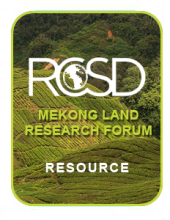Land Library
Welcome to the Land Portal Library. Explore our vast collection of open-access resources (over 74,000) including reports, journal articles, research papers, peer-reviewed publications, legal documents, videos and much more.
/ library resources
Showing items 28 through 36 of 778.The government of (post)socialist Laos has conceded more than 1 million hectares of land—5 percent of the national territory—to resource investors, threatening rural community access to customary lands and forests.
Land cover data is widely used for the design and monitoring of land use policies despite the incapability of this type of data to represent multiple land uses and land management activities within the same landscape.
Statutory recognition of rural communities as collective owners of their lands is substantial, expanding, and an increasingly accepted element of property relations.
Forest landscape restoration (FLR) considers forests as integrated social, environmental and economic landscapes, and emphasizes the production of multiple benefits from forests and participatory engagement of stakeholders in FLR planning and implementation.
This study investigated the implications of large-scale land concessions in the Red River Delta, Vietnam, and Northeast Cambodia with regard to urban and agricultural frontiers, agrarian transitions, migration, and places from which the migrant workers originated.
This paper undertakes a comparative analysis of rural-urban land conversion policies in China and Vietnam, and examines the ideology of the state in land policymaking under a market socialism environment.
Increasing global demand for natural rubber began in the mid-2000s and led to large-scale expansion of plantations in Laos until rubber latex prices declined greatly beginning in 2011. The expansion of rubber did not, however, occur uniformly across the country.
It is well known that in many rural communities in the developing world, forests, particularly those under community management, are important for people’s livelihoods.
As Chinese investment in foreign land and agriculture expands dramatically worldwide, a growing body of research has emerged on the prevalence of land deals in Latin America and Africa. Southeast Asia, however, has only recently begun to receive significant attention in these discussions.

